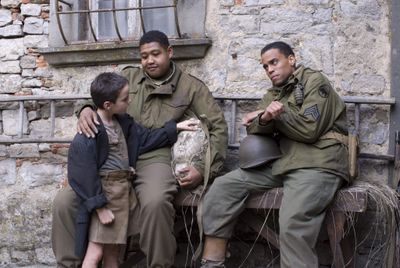Lee’s ambition backfires
‘Miracle at St. Anna’ runs too long, lacks focus

In Spike Lee’s long and eclectic career, “Miracle at St. Anna” is easily his most technically ambitious film.
But he might not have been ready for the enormity of such a project. “Miracle at St. Anna” is wildly unfocused in terms of tone and, at two hours and 40 minutes, it is unjustifiably overlong.
Lee didn’t write the script – that’s the work of James McBride, who based the screenplay on his novel of the same name – but he didn’t rein in his writer, either.
“Miracle” tells of the men of the 92nd Infantry Division, black troops who served in Italy during World War II and were known as Buffalo Soldiers.
Lee has long been critical of films about the war such as Clint Eastwood’s “Flags of Our Fathers” and “Letters From Iwo Jima” for depicting only the white U.S. soldiers who fought. This is his response – voluminous and full of unmistakable anger.
That’s not the only emotion that emerges in loud bursts. In following four soldiers trapped behind enemy lines in Tuscany (Derek Luke, Michael Ealy, Laz Alonso and Omar Benson Miller), Lee jumps from visceral battle scenes to intimate drama to lighthearted comedy.
Regardless of the situation, though, he smothers everything, as usual, in the distractingly horn-heavy score of his longtime collaborator, composer and jazz trumpeter Terence Blanchard.
The war violence (shot vividly by Matthew Libatique, also the cinematographer on Lee’s thrilling bank caper “Inside Man”) is bloody and gritty. But there’s clearly enough innate intensity there that he doesn’t need to amp it up through music.
Beginning in 1983 New York, but mostly told in flashback, “Miracle at St. Anna” follows the earnest leader Staff Sgt. Aubrey Stamps (Luke), smooth-talking Sgt. Bishop Cummings (Ealy), Puerto Rican translator Cpl. Hector Negron (Alonso) and the sweet, lumbering Private First Class Sam Train (Miller). Sent to ferret out the enemy, they take in an injured boy (Matteo Sciabordi) and hide out in a Tuscan village.
Somewhere along the way, Train picked up a piece of a demolished bridge: a woman’s head made of stone, which he totes everywhere because he swears it’s good luck. Part of the point of “Miracle” is uncovering the mystery of its meaning.
After finding some subtleties through his characters, moments like the film’s climax – the horrific event that took place at St. Anna and that explains everything – veer to the opposite extreme. And the absolute ending, when it finally comes, bangs you over the head in a completely different way that is no less strenuous.
– By Christy Lemire, The Associated Press
“Frozen River”
Abandoned by her compulsive-gambler husband, and ignored for a promotion at the dollar store where she works, Ray Eddy (Melissa Leo) crosses paths with Lila (Misty Upham), who lives on the nearby Mohawk reservation.
To earn quick money, Lila persuades Ray to drive illegal immigrants across a frozen river, which won’t get them into trouble as long as they stay on the rez.
It comes as no shock when events spiral out of the women’s control. But “Frozen River,” written and directed by promising newcomer Courtney Hunt, possesses all manner of surprises.
Made with uncommon skill and assurance, the film never succumbs to rank sentimentality, but it manages to get at the nuances of human relationships. “Frozen River” is at its best when it captures the lengths to which parents will go for their kids – and what they ask of them.
– By Ann Hornaday, The Washington Post